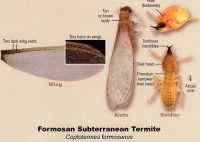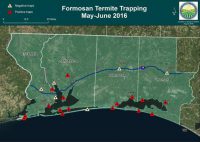 The genus Coptotermes contains the largest number of termite pests (28 species) worldwide, with the Formosan subterranean termite, Coptotermes formosansus, being the most widely distributed and most economically important. During the 1960’s it was found in Texas, Louisiana, and South Carolina. The first well-established colony in Florida was reported in 1980.
The genus Coptotermes contains the largest number of termite pests (28 species) worldwide, with the Formosan subterranean termite, Coptotermes formosansus, being the most widely distributed and most economically important. During the 1960’s it was found in Texas, Louisiana, and South Carolina. The first well-established colony in Florida was reported in 1980.
A single colony of Formosan subterranean termite may contain several million termites that forage up to 300 feet in soil. Once established, the Formosan subterranean termite has never been eradicated from an area. Therefore, monitoring of movement of the species is critical. Beginning in 2015, the Florida Department of Agriculture of Consumer Science (FDACS) began trapping the alates. Termites have three primary castes: the reproductive, soldiers, and workers. Within the reproductive caste, the young females, referred to as alates, are the ones that leave the colony. They are able to form wings and seek new areas to become established. Dispersal flights or “swarms” are massive and begin at dusk on calm and humid evenings from April to July. Alates are attracted to lights.
The objective of the FDACS Formosan Termite Alate project is to trap alates throughout the four most western counties of the Panhandle during their major swarm season in May and June, which is the time they are most active in that part of Florida. Trapped alates were counted on a weekly basis to determine peak swarming weeks. White, gridded 7”x 4” sticky card attached to 6’ stakes are placed under strong, predetermined street lights. Twenty-two trap locations were selected, each representing a key Panhandle community with at least one location North of I-10 within each of the four counties.
In 2016, sixteen out of the 22 traps were positive for Formosan termite alates throughout the four Panhandle counties. Formosan alates were caught during 7 of the 8 weeks of trapping. The largest spike in numbers trapped was during the week of May 8th. A subsequent swarming spike occurred during the week of May 22nd. Trap locations that were positive in 2016 and not 2015 included Pensacola Beach, Destin, Blue Mountain Beach, Okaloosa Island and Choctaw Beach. The project will be continued each year in order to determine some of the problem areas.
For more information go to:
http://www.freshfromflorida.com/Divisions-Offices/Agricultural-Environmental-Services/Consumer-Resources/Protect-Your-Home-from-Pests/Termites/Formosan-Termite-Program
Latest posts by Sheila Dunning (see all)
- Florida Certified Horticulture Professional Training - December 3, 2021
- Gulf States Horticulture Expo 2022 - December 3, 2021
- Empty Fields? Time to tackle turfgrass improvement projects! - April 27, 2020